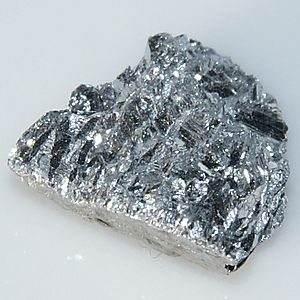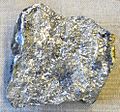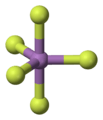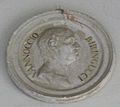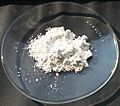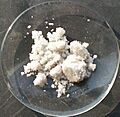Antimony facts for kids
Antimony is a chemical element. It has the chemical symbol Sb. This symbol comes from its old Latin name, 'stibium'. Antimony has an atomic number of 51. Its atomic mass is 121.8. It's a blue-gray element that can be a bit harmful if not handled carefully.
Contents
Properties of Antimony
Physical Properties
Antimony can exist in different forms called allotropes. The most common form is a blue-white metalloid. A metalloid is an element that has properties of both metals and nonmetals. This common form looks black when it's a powder. It is also brittle, soft, and shiny.
There are also yellow and black forms of antimony. These are unstable nonmetals. Yellow antimony is only found in very cold places. It changes into black antimony when it gets light or warmer. Black antimony can even catch fire by itself! There's also an explosive form of antimony. This form explodes when it changes into the common metallic form. When people talk about antimony, they usually mean the common blue-white metalloid form.
Antimony has two stable (not radioactive) isotopes found in nature: Sb-123 and Sb-121.
Chemical Properties
Antimony is not a very reactive element. It doesn't easily dissolve in most acids. However, it can dissolve in strong oxidizing acids like nitric acid or sulfuric acid. It doesn't easily rust or change when exposed to air.
When antimony burns in air, it creates antimony trioxide. If there's a lot of air, it can also form antimony tetroxide.
Antimony Compounds
Antimony forms chemical compounds in different ways, known as oxidation states: -3, +3, and +5.
- -3 Compounds
These compounds are called antimonides. They are made when antimony reacts with other metals. When antimonides react with acids, they create a harmful and unstable gas called stibine.
- Aluminium antimonide: A black solid.
- Stibine: An unstable, colorless gas.
- Zinc antimonide: A gray solid.
- +3 Compounds
These are the most common antimony compounds. They are usually colorless or light yellow solids. They are considered weak oxidizing agents.
- Antimony tribromide: A colorless solid that reacts with water.
- Antimony trichloride: A colorless or pale yellow solid that reacts with water.
- Antimony trifluoride: A light gray solid that dissolves in water.
- Antimony triiodide: A yellow solid that reacts with water.
- Antimony trioxide: A white solid and the most common antimony compound.
- Antimony trisulfide: A gray, flammable solid.
- Mixed Oxidation State
Antimony tetroxide is a special compound. It contains antimony in both its +3 and +5 oxidation states.
- +5 Compounds
These compounds are strong oxidizing agents. They are not as common as the +3 compounds.
- Antimony pentachloride: A pale yellow liquid.
- Antimony pentafluoride: A colorless, oily liquid.
- Antimony pentoxide: A yellow solid.
History of Antimony
People have known about antimony sulfide for a very long time. Some items covered with antimony or made from it have been found in ancient Egypt and Chaldea. The first time antimony was written about in Europe was in the 1540s. The first time pure antimony was found in nature was in Sweden in 1783. In ancient times, antimony sulfide and pure antimony were sometimes confused.
Where Antimony is Found
Antimony is not a very common element. It's found about as often as thallium. However, it's quite easy to get because it's present in many minerals. Sometimes, antimony is found as a pure element, but usually, it's found as stibnite. Stibnite is a mineral made of antimony sulfide and is the main source of antimony.
China is the biggest producer of antimony, making 84% of the world's supply. Other countries that produce antimony include South Africa, Bolivia, and Kyrgyzstan. Antimony is not used in the human body.
How Antimony is Made
Antimony is usually made from stibnite. One way is to heat stibnite with air. This process creates antimony trioxide. Because it gets very hot, the antimony trioxide turns into a gas. Other metal oxides in the stibnite ore do not evaporate. The antimony trioxide gas is then collected and cooled in a container. This collected antimony trioxide is then heated with carbon to produce carbon dioxide and pure antimony.
Another way to make antimony is by heating stibnite with scrap iron. This reaction creates iron(II) sulfide and antimony. The pure antimony is then separated and used.
Uses of Antimony
About half of all antimony produced is used to make antimony trioxide. This compound is used for flame proofing materials, helping them resist fire.
Antimony is also used to make alloys with lead. An alloy that is 5% antimony and 95% lead is much harder than pure lead. This alloy is used in lead-acid batteries, which are found in cars. It's also used in the pipes of pipe organs. Pewter is another alloy that contains antimony. Some lead-free solder also has antimony in it. Antimony-lead alloys are used in ammunition for small arms and to cover cables. It's also used in alloys that have very little friction, like Babbitt metal.
Another important use for antimony is as a catalyst in making some plastics. Antimony trioxide is added to some glass to remove bubbles, which is useful for things like television screens. Antimony is also used as a dopant in electronics, which means it's added in small amounts to change how electronic materials work.
In the past, some antimony compounds were used as medicines to kill tiny organisms called protozoans. Antimony sulfide is also used in matches.
Safety Information
Antimony is toxic. Its harmfulness is similar to arsenic, though it is less toxic. Breathing in antimony dust can be very dangerous. Antimony also reacts with strong oxidizing agents. There have been some concerns about small amounts of antimony coming out of plastic bottles where antimony was used as a catalyst during manufacturing.
| Periodic table | |||||||||||||||||||||||||||||||||||||||||
|---|---|---|---|---|---|---|---|---|---|---|---|---|---|---|---|---|---|---|---|---|---|---|---|---|---|---|---|---|---|---|---|---|---|---|---|---|---|---|---|---|---|
| H | He | ||||||||||||||||||||||||||||||||||||||||
| Li | Be | B | C | N | O | F | Ne | ||||||||||||||||||||||||||||||||||
| Na | Mg | Al | Si | P | S | Cl | Ar | ||||||||||||||||||||||||||||||||||
| K | Ca | Sc | Ti | V | Cr | Mn | Fe | Co | Ni | Cu | Zn | Ga | Ge | As | Se | Br | Kr | ||||||||||||||||||||||||
| Rb | Sr | Y | Zr | Nb | Mo | Tc | Ru | Rh | Pd | Ag | Cd | In | Sn | Sb | Te | I | Xe | ||||||||||||||||||||||||
| Cs | Ba | La | Ce | Pr | Nd | Pm | Sm | Eu | Gd | Tb | Dy | Ho | Er | Tm | Yb | Lu | Hf | Ta | W | Re | Os | Ir | Pt | Au | Hg | Tl | Pb | Bi | Po | At | Rn | ||||||||||
| Fr | Ra | Ac | Th | Pa | U | Np | Pu | Am | Cm | Bk | Cf | Es | Fm | Md | No | Lr | Rf | Db | Sg | Bh | Hs | Mt | Ds | Rg | Cn | Uut | Fl | Uup | Lv | Uus | Uuo | ||||||||||
|
|||||||||||||||||||||||||||||||||||||||||
Images for kids
-
Native antimony with oxidation products
-
Stibnite, China CM29287 Carnegie Museum of Natural History specimen on display in Hillman Hall of Minerals and Gems
See also
 In Spanish: Antimonio para niños
In Spanish: Antimonio para niños


